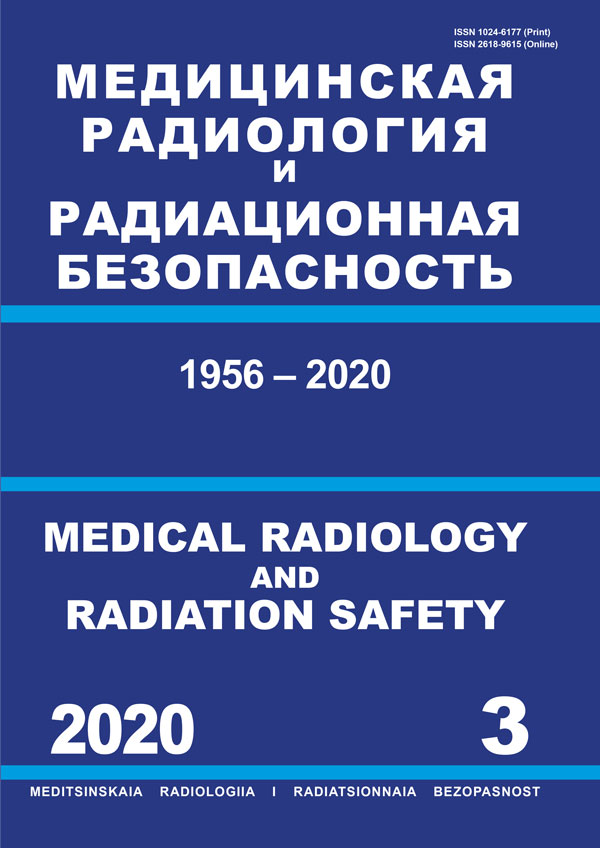Russian Federation
CSCSTI 34.49
CSCSTI 86.40
CSCSTI 87.33
Russian Classification of Professions by Education 14.02.02
Russian Trade and Bibliographic Classification 6027
Russian Trade and Bibliographic Classification 6362
BISAC MED080000 Radiology, Radiotherapy & Nuclear Medicine
BISAC SCI058000 Radiation
Purpose: Development of recommendations on the use in medical practice of institutions under FMBA of Russia of operational values of radioactive skin contamination in the event of radiological accidents. Material and methods: The easily measured radiation parameters were used as operational values: ambient dose equivalent rate (ADER) of γ-radiation, density of skin contamination with γ-, β- and α-emitting radionuclides. Operational values of skin contamination were estimated on the basis of experimental data described in the literature and models on the kinetics of radioactive substances transport in the body, accepted values of dose criteria for deterministic and stochastic effects. The estimation of radioactive material resorption through the skin was based on the results of experimental studies in laboratory animals (mainly piglets) for a limited set of chemical compounds of radionuclides. Results: The values of γ-ADER of the main dose-forming radionuclides measured at a distance of 10 cm from the skin surface in the range of 10–1000 μSv/h and the possible health effects due to the skin exposure and the intake of radioactive substances into the body were presented. In the IAEA recommendations, the level of skin contamination at 1 µSv/h is considered as a significant operational value according to the criterion of radioactive substances intake through the mouth from the contaminated surface of the hands. However, in our opinion, this estimate is excessively conservative; therefore it is not included in the recommended operational values. If the skin is contaminated with γ-β-emitting radionuclide solutions at a surface contamination higher than 106 Bq/cm2 (ADER ≥1000 µSv/h), the out of turn emergency decontamination should be carried out. Obligatory indications for the whole body counter examination after thorough decontamination and conducting biophysical analysis of bioassay are the following operational values: γ-ADER from the skin > 10 µSv/h; surface contamination of intact skin with β-active radionuclides > 20 000 β-part./(cm2·min); surface contamination of intact skin with α-active radionuclides > 200 α-part./ (cm2·min). Conclusion: The recommended operational values allow preliminarily and promptly to assess the health risk not only in the case of external (contact) exposure of the skin and underlying tissues, but also due to the intake of soluble radioactive substances into the body through intact and damaged (injured) skin. Taking into account the high degree of uncertainty of the estimates obtained, the operational values should be considered as strictly conservative. They should be used only to determinate of urgency of decontamination carrying out for the provision of medical care during the prehospital and early hospital periods with the obligatory follow-up dosimetry examination for the final assessment of absorbed dose.
radiological accident, radiological terrorism, radioactive skin contamination, operational values, decontamination, medical assistance
1. Grachev MI, et al. Medical Aspects of Countering Radiological and Nuclear Terrorism. Moscow. 2018. 392 p. (In Russ.).
2. The Radiological Accident in Goiania. Vienna: IAEA. 1988. 149 p.
3. Dangerous Quantities of Radioactive Material (D-values). Vienna: IAEA. 2006. 145 p.
4. Ilyin LA, et al. Radioactive substances and skin (metabolism and decontamination). Moscow. 1972. 304 p. (In Russ.).
5. Kalistratova VS, ed. Radiobiology of incorporated radionuclides. Moscow. 2012. 464 p. (In Russ.).
6. MU 2.6.5.029-2016. Individual dosimetric control in the event plutonium and americium enter the wound. General requirements. Guidelines. (In Russ.).
7. MU 2.6.1.034-2014. The procedure for interaction between the enterprises of Rosatom State Corporation and the bodies and organizations of the FMBA of Russia in case of non-standard (wound) and emergency inhalation intake of plutonium and americium-241 isotopes. Guidelines. (In Russ.).
8. Preparedness and Response for a Nuclear or Radiological Emergency. General Safety Requirements No. GSR Part 7. Vienna: IAEA. 2015. 102 p.
9. General procedures for assessment and response during a radiological emergency. IAEA-TECDOC-1162. Emended version, 2013. Vienna: IAEA. 2000. 183 p.
10. Operational radiation and medical criteria for urgent protective measures in the event of a radiation accident at FSUE SevRAO. Guidelines. 2008. (In Russ.).
11. Petushkov VN, et al Surgical problems of treating patients affected by the Chernobyl accident. In: Immediate and long-term consequences of a radiation accident at the Chernobyl NPP: Proceed. of the All-Union Symposium, June 25-26; 1987. M. 1987. 521-5. (In Russ.).





